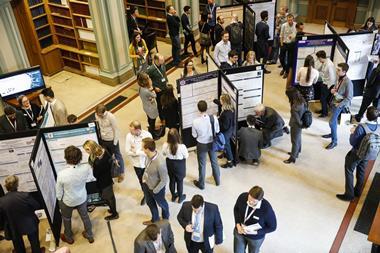Five tips for attracting attention to your work
‘Posters are a great way to discover new science and meet new people,’ says Luke Wilkinson, a coordination chemist at the University of York, UK. ‘These sessions are a valuable experience for everyone, from master’s students making their first foray into research, through to the seasoned academics.’ For many though, a poster presentation can be an intimidating prospect, particularly for new researchers. Here are a few suggestions you can follow to create effective posters for any platform and present them confidently.
Make it eye-catching
Posters are very visual, so your design needs to stand out and attract attention, whether that’s across a crowded room, or in a busy Twitter thread. ‘Big, interesting images draw the eye,’ says Edward Gardner, a development editor at the Royal Society of Chemistry, and one of the co-organisers of the RSC’s annual #RSCPoster event on Twitter. ‘Especially online, it’s helpful for people to get a sense of the content without having to zoom in too much.’ There is no prescribed layout, and different designs work better for different audiences and events. ‘You can be very creative with how you present the information as long as it’s easy to follow,’ says Laura Ghandhi, a deputy editor at the RSC who also co-organises #RSCPoster. ‘My number one tip would be: do not make it too word heavy. Use the minimum text that you need to make your point clear.’
Choose your content carefully
‘Posters don’t have to show complete work,’ says Wilkinson. ‘They can just show the concept and a few preliminary results. As long as you’re not sharing sensitive material, it’s never too early to present.’ Conference-goers are looking for digestible chunks of information, quickly showing what your research is hoping to achieve and how you plan on getting there. Less is more when designing a poster and it’s actually much better to focus on a few key results and tell a clear and logical story. ‘I would always include the smoking gun experiments,’ says Wilkinson. ‘The ones that definitively proved your hypothesis, or that threw a spanner in the works.’ Leaving something for people to ask can be a great ice breaker and you can provide additional information using QR codes or hyperlinks for those with a special interest.
Tell a complete story
Presenting a poster is not just about sharing your latest results. ‘The first thing I think about when I see a poster is “Why do I care about this piece of science?”’ says Ghandhi. ‘You need to make the context of your research clear in the introduction.’ This is especially important at general events such as departmental symposia or social media conferences where many attendees will not be specialists in your research area. People are put off by impenetrable lists of results, but by starting at the beginning and guiding your audience through the background and aims of your work, you can effectively share your research with anyone. Ghandhi also emphasises the importance of a concluding section. ‘It’s really hard to get to the take home message without one,’ she says. ‘Think about the key idea you want people to remember about your poster.’
Consider your platform
‘One of the most important considerations is the platform,’ says Gardner. ‘How are people viewing your poster and how are they going to initially arrive at it?’ Social media is a powerful tool for sharing science and increasing numbers of events are now taking place on platforms such as YouTube or Twitter. Users on these sites are looking for engaging bitesize chunks of information, often viewed on mobile phones, meaning online poster formats need to work across multiple different devices. ‘There’s lots of advice about how to adapt your poster to different platforms,’ says Gardner. ‘For #RSCPoster, we focus on Twitter and it can be really effective to include additional features like gifs and videos, which aren’t available for traditional posters.’ The #RSCPoster event is heavily publicised to drive traffic to the relevant threads, but the team recommends using suitable hashtags or promoting your poster on other social media accounts to help direct people to your work.
Prepare to present
Perhaps simultaneously the most valuable and most intimidating part of a poster session is presenting the poster itself. Make sure you’re happy with the work you’re presenting and take the opportunity to discuss any doubts with your supervisor. ‘It’s really important to have confidence in yourself, as well as your research, knowing you’re going to be challenged,’ says Wilkinson. ‘But most people just want to hear about your science. They’re not there to criticise you.’ Ghandhi suggests practising your elevator pitch with friends or colleagues before the event. ‘You don’t want to be just reading off your poster,’ she says. ‘Share a bit of background about your experiments and build a rapport with other researchers.’
The 2023 #RSCPoster Twitter conference starts on 28 February. Find out more and register here
The 2023 #RSCPoster Twitter conference starts on 28 February. Find out more and register here rsc.org/events/detail/75565/2023-rscposter-twitter-conference
The 2023 #RSCPoster Twitter conference starts on 28 February. Find out more and register here rsc.org/events/detail/75565/2023-rscposter-twitter-conference













No comments yet